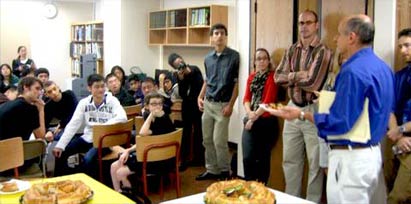The Bronx High School of Science
The Bronx, New York
The Bronx High School of Science is an institute that would make Lisa Simpson insanely jealous. Known for a rigorous curriculum and as a gateway to the Ivies, its famous graduates include seven national medal of science winners, six Pulitzer Prize recipients, three former Secretaries of the Armed Forces, and physical, life, and mathematical scientists galore. It holds one other important distinction: Bronx Science’s alumni have won more Nobel Prizes in physics than any other secondary school in the United States.1 Take that, Springfield Elementary.
In celebration of the achievements of the school in the annals of physics history, the Bronx High School of Science was honored as an APS Historical Site. On October 15, 2010, APS presented the school with a plaque that reads: “In this school generations of students from every economic and cultural background encountered their first experiences which would lead to great achievements in science and technology, as witnessed by the seven Nobel Prizes in physics awarded between 1972 and 2005 to its graduates, the largest number for any high school in America.”
The school was founded in 1938 with 400 male students. It welcomed females, ahead of other similar schools in New York, in 1946. Its newspaper was called “Science Survey” and its colors, green and gold, were selected for their scientific virtue – green to symbolize chlorophyll and gold for the sun.2 By 1959, the institute had evolved beyond the walls of its ageing edifice, and Bronx Science moved to a new location. Its shiny new building is still known not only for the parade of intelligence that trumpets through its corridors, but also for a powerful mural that can be seen from outside. The 63-foot work of art, made of Venetian glass mosaic, depicts scientists such as Marie Curie and Charles Darwin, and is entitled “Humanities Protecting Biology, Physics, Chemistry”. It carries the quote “Every great advance in science has issued from a new audacity of imagination."3
Bronx Science’s list of alumni read like a veritable Who’s Who of physics and other sciences. Among the first class of pupils in 1938 was Roy Glauber, who won the Nobel Prize in physics in 2005 for his research on quantum optics. There was no physics course until 1939, when it was introduced with a textbook that did not even discuss atoms. Glauber’s math teacher presented him a text on calculus to dive into during the summer, and the future Laureate became entranced. When he entered Harvard University in 1942, he passed over the intermediate physics courses and pursued a graduate curriculum, before he was invited to Los Alamos to participate in the development of the atomic bomb.4
Caltech professor David Politzer, who shared the 2004 Nobel Prize in Physics for his contributions to quantum chromodynamics, spoke at the plaque presentation ceremony. He characterized the essence and energy of Bronx Science with a tale concerning the transit strike of 1966, the year he graduated. “The strike paralysed the city for almost two weeks and in most schools attendance plummeted; in some, nobody turned up. ‘[But] at Bronx Science, attendance was normal,’ Politzer recalls. ‘We walked, bicycled and hitchhiked to school. We wouldn't miss it!’”5
1 “About Bronx Science,” The Bronx High School of Science, as of November 2010.
2 Ibid.
3 “About Bronx Science,” The Bronx High School of Science Alumni Association and Endowment Fund, as of November 2010.
4 Crease, Robert P., “Bronx Physics,” Physics World, November 2, 2010.
5 Ibid.
Nobel Laureate David Politzer (in blue shirt) addresses physics students at the Bronx High School of Science as part of the festivities commemorating the school as an historic physics site. Few universities and no high school has produced as many Nobel Laureates as Bronx Science.

